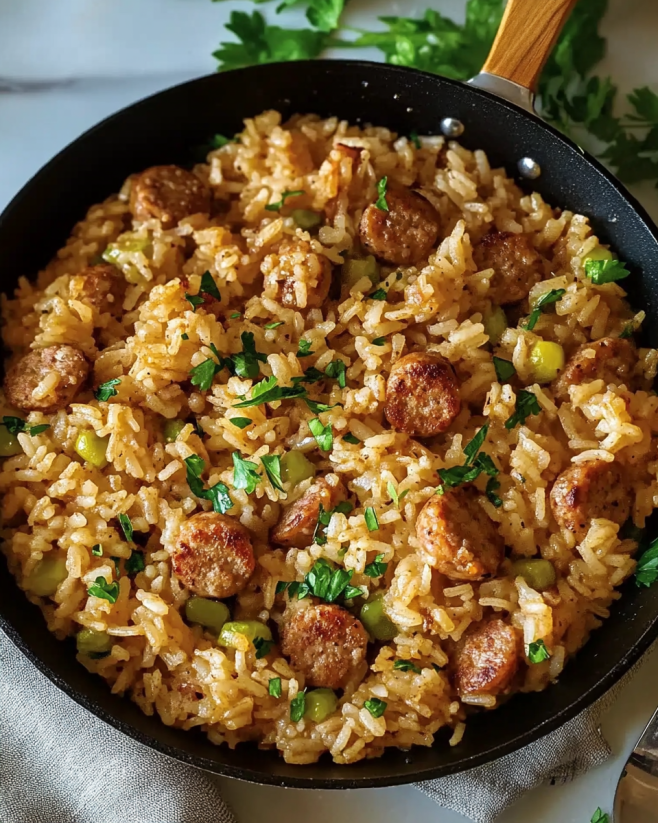When it comes to quick and flavorful meals, few dishes rival the versatility and ease of the Cajun Sausage and Rice Skillet. This dish is a staple in Southern kitchens, embodying the bold, spicy flavors of Cajun cuisine while remaining accessible to cooks of all skill levels.
FULL RECIPE:
Ingredients
- 12 oz smoked sausage (e.g., Andouille or Kielbasa), sliced into ½-inch rounds
- 1 cup long-grain white rice, rinsed
- 1 red bell pepper, diced
- 1 green bell pepper, diced
- 1 medium yellow onion, diced
- 3 cloves garlic, minced
- 1½ cups chicken broth
- 2 tbsp Cajun seasoning
- 1 tbsp olive oil
- Salt and pepper to taste
- Optional garnishes: fresh parsley, green onions, or a drizzle of hot sauce
Directions
- Prepare the Ingredients
Slice the sausage into ½-inch rounds. Dice the bell peppers and onion, and mince the garlic. Rinse the rice under cold water until the water runs clear.
- Cook the Sausage
Heat 1 tablespoon of olive oil in a large skillet over medium heat. Add the sliced sausage and cook for 5-7 minutes, until browned and crispy on the edges. Remove the sausage from the skillet and set aside.
- Sauté the Veggies
In the same skillet, add the diced onion and bell peppers. Sauté for about 3 minutes, until softened. Add the minced garlic and cook for an additional minute until fragrant.
- Toast the Rice
Add the rinsed rice to the skillet, stirring to coat it with the vegetables and oil. Toast the rice for about 2 minutes, stirring occasionally, until it smells fragrant.
- Cook the Rice
Pour in the chicken broth and sprinkle in the Cajun seasoning. Stir well and bring to a boil. Once boiling, reduce the heat to low, cover, and simmer for 15-20 minutes, or until the rice is tender and the liquid is absorbed.
- Combine and Finish
Once the rice is cooked, add the sausage back to the skillet. Stir everything together, cooking for an additional 3-5 minutes to blend the flavors.
- Serve
Serve hot, garnished with chopped parsley, green onions, and a drizzle of hot sauce if desired.
Nutrition Facts
- Calories: 450 kcal
- Total Fat: 28.8g
- Saturated Fat: 9.6g
- Trans Fat: 0g
- Cholesterol: 80mg
- Sodium: 1328.93mg
- Total Carbohydrates: 50.8g
- Dietary Fiber: 4.15g
- Sugars: 4g
- Protein: 22.23g
- Vitamin A: 1124IU
- Vitamin C: 58mg
- Calcium: 38mg
- Iron: 3mg
The Essence of Cajun Cuisine
Cajun cuisine originates from the Acadian people who settled in Louisiana. Over time, they developed a unique culinary style influenced by French, Spanish, and Native American cooking traditions. This cuisine is known for its bold use of spices, hearty proteins, and the combination of simple yet flavorful ingredients that create rich, complex dishes. One of the hallmarks of Cajun cooking is the “Holy Trinity” of vegetables onions, bell peppers, and celery which serve as the flavor foundation for many dishes, including gumbo, jambalaya, and étouffée. While celery is not always included in skillet recipes like this one, the use of onions and bell peppers remains essential for developing the classic Cajun taste.
The Role of Smoked Sausage
Smoked sausage is a key ingredient in this dish, providing a rich, savory depth that enhances the overall flavor profile. Traditional Cajun recipes often use Andouille sausage, a smoked pork sausage that is heavily seasoned with garlic, pepper, and other spices. However, other smoked sausages like Kielbasa or chorizo can be used as substitutes, each bringing its own distinct flavor. When cooked in a skillet, the sausage develops a slightly crispy exterior while releasing flavorful oils that infuse the dish with a smoky, spiced undertone. This step not only enhances the taste of the sausage itself but also helps create a flavorful base for the rice and vegetables.
The Importance of Cajun Seasoning
Cajun seasoning is a blend of spices that gives this dish its characteristic heat and depth. Common ingredients in Cajun seasoning include paprika, cayenne pepper, garlic powder, onion powder, oregano, and thyme. Some variations may also contain salt, black pepper, and dried mustard. While store-bought Cajun seasoning works well, making your own blend at home allows for customization based on personal spice preferences. A homemade mix can be adjusted to be milder or spicier, ensuring the perfect level of heat for every palate.
Customization and Ingredient Variations
While the classic version of this recipe includes smoked sausage, bell peppers, and Cajun seasoning, there are many ways to customize it to suit different tastes and dietary needs.
- Protein Variations: Instead of sausage, try using shrimp, chicken, or a plant-based alternative like tofu or tempeh. If using shrimp, add them towards the end of cooking to prevent overcooking.
- Vegetable Additions: Additional vegetables such as celery, tomatoes, zucchini, or mushrooms can enhance the dish’s texture and nutritional value.
- Rice Alternatives: Although long-grain white rice is traditionally used, brown rice, quinoa, or cauliflower rice can be substituted for a healthier or low-carb option. Note that brown rice takes longer to cook and may require additional liquid.
- Spice Adjustments: Adjust the level of heat by increasing or decreasing the amount of cayenne pepper or adding diced jalapeños. For those who prefer a milder dish, reducing the Cajun seasoning or opting for a less spicy sausage can help balance the flavors.
Pairing Suggestions
The bold flavors of this Cajun dish pair well with a variety of side dishes and accompaniments. Some great options include:
- Cornbread: A classic Southern staple that balances the spice of the skillet dish with its slight sweetness.
- Coleslaw: A cool, creamy coleslaw provides a refreshing contrast to the heat of the Cajun spices.
- Steamed Greens: Collard greens, spinach, or kale sautéed with garlic and olive oil make for a nutritious side.
- Black Beans: Adding a side of black beans or red beans enhances the protein and fiber content of the meal.
- Garlic Bread: A warm, buttery slice of garlic bread is perfect for soaking up the flavorful juices from the skillet.
Storage and Meal Prep Tips
This dish is an excellent choice for meal prep because it stores well and reheats easily. Here are some storage tips:
- Refrigeration: Store leftovers in an airtight container in the refrigerator for up to 4 days.
- Freezing: The cooked dish can be frozen for up to 3 months. Allow it to cool completely before transferring it to a freezer-safe container. To reheat, thaw overnight in the refrigerator and warm it in a skillet with a splash of chicken broth to refresh the flavors.
- Reheating: To maintain the best texture, reheat on the stovetop over medium heat, stirring occasionally. If using a microwave, add a few drops of water to prevent the rice from drying out.
Health Benefits of the Cajun Sausage and Rice Skillet
Despite its indulgent flavors, this dish can be a balanced meal when made with nutritious ingredients. The combination of protein, carbohydrates, and vegetables ensures a well-rounded dish that provides energy and essential nutrients.
- Protein: Smoked sausage, when paired with rice, creates a complete protein source that supports muscle repair and overall health.
- Vitamins and Minerals: Bell peppers are rich in vitamin C, which boosts the immune system, while onions provide antioxidants that support heart health.
- Fiber: If made with brown rice or added vegetables, the dish can be high in fiber, promoting digestion and satiety.
Conclusion
The Cajun Sausage and Rice Skillet is a celebration of bold flavors, simple ingredients, and easy cooking techniques. This one-pan wonder delivers an irresistible mix of smoky, spicy, and savory flavors that make it a standout dish in any household. Its adaptability and minimal cleanup make it an excellent choice for busy individuals who still want a hearty, home-cooked meal.






